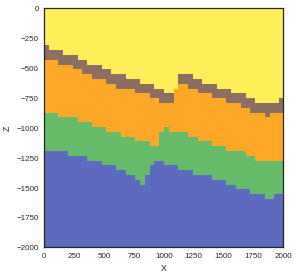GemPy is an open-source, Python-based 3-D structural geological modeling software, which allows the implicit (i.e. automatic) creation of complex geological models from interface and foliation data. It also sports support for stochastic modeling to adress parameter and model uncertainties.
GemPy uses interface (i.e. layer interface points, fault plane points) and foliation data (i.e. dip values of the surfaces) as input. The following plot shows exemplatory input data of four different lithology interfaces and a fault interface (blue), with only two dip measurements (arrows).
From this input data GemPy can implicitly construct a full 3-D structural geological model:
GemPy requires Python 3.X and makes use of numerous open-source libraries:
numpypandasmatplotlibseaborntheano
Optional:
vtkfor interactive 3-D visualization (VTK v. 7.X is required for Python 3)skimageandnetworkxfor 3-D topology analysis and graph handling
Overall we recommend the use of a dedicated Python distribution, such as Anaconda, for hassle-free package installation. We are curently working on providing GemPy also via Anaconda Cloud, for easier installation of its dependencies.
Installing the latest release version of GemPy itself is easily done using PyPI:
$ pip install gempy
Otherwise you can clone the current repository:
$ git clone https://github.com/cgre-aachen/gempy.git
And manually install it using the following command in the repository directory:
$ python install.py
Extensive documentation for GemPy is hosted at gempy.readthedocs.io, explaining its capabilities, the theory behind it and providing detailed tutorials on how to use it.



